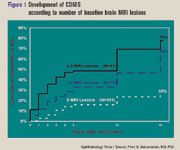Article
Brain MRI useful for predicting risk of MS in optic neuritis
Long-term outcomes of a study of optic neuritis have shown that even one brain lesion ≥3 mm at the time of the first episode can be predictive of development of multiple sclerosis, making a brain MRI an essential part of patient management.

Key Points
Baltimore-A brain MRI study performed at the first episode of optic neuritis has been validated as a tool that can reliably predict which patients are at high risk of developing clinically definite multiple sclerosis (CDMS). An accompanying ophthalmologic examination also is critical, particularly in patients with normal MRI results, because it can clarify risk status, according to Prem S. Subramanian, MD, PhD, visiting associate professor of ophthalmology, Wilmer Eye Institute, Johns Hopkins University, Baltimore.
These conclusions are based on 15-year results of the Optic Neuritis Treatment Trial (ONTT) and the Longitudinal Optic Neuritis Study (LONS). ONTT/LONS began 20 years ago; 454 eligible subjects were enrolled between July 1988 and June 1991; annual exams were performed through 1997. Ten-year follow-up exams occurred in 2001 to 2002; the 15-year follow-up exams were performed in 2006. Approximately 78% of the original study population participated in the 15-year examination.
The ONTT was designed to evaluate patients who presented with their first episode of optic neuritis. Researchers already knew that patients with optic neuritis were at risk of developing MS, but no systematic review of the association had been conducted, Dr. Subramanian said. Investigators set out to determine the natural history of vision in patients with optic neuritis, assess the effects of treatment with corticosteroids, and identify risk factors for development of CDMS.
Throughout the trial, patients were followed at various intervals, surveyed by phone, and brought back to clinical centers throughout the United States for ophthalmologic and neurologic exams. Five-year and 10-year results have been published; findings from the 15-year follow-up exams are being prepared for publication.
Ongoing questions were whether development of CDMS several years after the diagnosis of optic neuritis was a linear process and whether it could be predicted based on specific risk factors, said Dr. Subramanian, who was not involved in the early years of the study. Working at Johns Hopkins University, one of the ONTT/LONS clinical centers, he had access to the data and the opportunity to examine some of the patients.
Assessing risk

Newsletter
Don’t miss out—get Ophthalmology Times updates on the latest clinical advancements and expert interviews, straight to your inbox.




